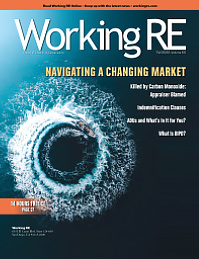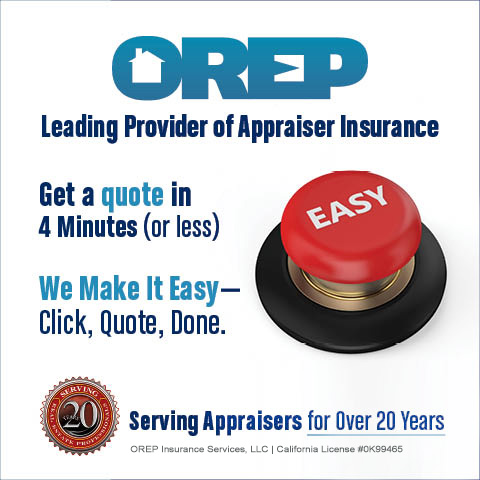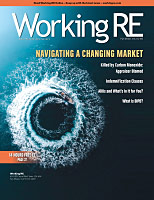 |
> The Appraiser Coach
> OREP E&O |
What’s New at the VA?
Interview with VA’s Chief Appraiser
by Isaac Peck, Senior Broker at OREP.org
The appraisal industry is abuzz with changes and challenges—appraisal volume has slowed, desktop and hybrid appraisals are becoming available options for Veteran buyers, as appraisers face fee pressures from AMCs who are taking extraordinary measures to make up for the low volume they’re facing.
In the midst of all this, the United States Department of Veteran Affairs (VA), is known throughout the valuation community for respecting the work of appraisers and maintaining reasonable fee schedules.
James Heaslet, Chief Appraiser at the VA, sat down with Working RE to share his thoughts on some of the changes in the appraisal industry. Heaslet is a retired United States Marine Corps Veteran, and a second-generation appraiser who began his valuation career as a trainee at his father’s office in 2007.
In July 2022, VA published procedures for Alternative Valuation Methods, Circular 26-22-13. This procedure allows desktop appraisals on purchase transactions when a lender is approved to participate in the Lender Appraisal Processing Program, the purchase price does not exceed the conforming loan limit for the jurisdiction, the property is a single-family home, and the Veteran is making a down payment of at least 20% of the purchase price or the appraisal request has been unassigned for over 7 business days.
Question: Fannie Mae and Freddie Mac are making desktop appraisals a permanent fixture in their valuation offerings. Is the VA looking at these types of valuations and what are some of the considerations?
Heaslet: As mentioned, VA issued procedures for expanding desktop appraisals in July and also made clarifications regarding how appraisers can effectively use the Assisted Appraisal Processing Program (AAPP). We see it as a tool in our toolbox. The VA assists service members and Veterans throughout the country, including those living in some very remote rural locations where fewer appraisers are available. To bridge this gap in capability to serve our borrowers, VA assesses that a desktop product might help us provide better service. VA’s focus is on how to best serve all of our Veterans and service members. So, in markets where we don’t have access to a lot of appraisers, we can see a use for this desktop approach.
One of the primary considerations on where VA might deploy this desktop tool is in how VA determines the need. For example, in Southern California, there are plenty of appraisers available. As interest rates continue to rise, these appraisers are eager to work. So, I don’t think we’d need a desktop valuation in a major metroplex or an area where we’ve got enough appraisers. In any market where we’re seeing longer turn-times or a lower valuation capacity, the desktop tool is one way we can address that.
Under AAPP, the appraisal report may be completed based solely on information gathered by a person with whom the VA fee panel appraiser has entered into an agreement for such services. In some parts of the country, there are shortages of appraisers. This is an industry-wide concern that is not unique to VA. This program will help promote the training of more appraisers. We also believe it will reduce appraisal timeframes. This tool can be leveraged on most appraisals, however complex assignments, new construction, and properties valued at over $1 Million are excluded from the AAPP. Veterans are protected as the appraisal must still meet the Uniform Standards of Professional Appraisal Practice (USPAP). We’ve had it active for over two years now and are collecting data on how it is being used, exploring the pain points, and assessing any necessary modifications we can make to improve it for all VA stakeholders. Ultimately, the goal is to expand it and make it more user-friendly.
Question: Great point! What kind of feedback have you received about AAPP so far?
Heaslet: So far, we are pleased with the results from appraisers who have been using AAPP and we think it’s a great way to encourage trainees. However, we continue to see lenders who opt-out of allowing the appraiser to use it. We try to educate lenders and explain how they can enjoy greater flexibility with AAPP and they typically are very receptive to those conversations, as they know that the appraisal will still meet all VA guidelines as well as USPAP and that the experienced VA fee appraiser is still accepting full responsibility for the appraisal report.
So, VA is looking to build on the AAPP initiative and get better expansion in the rural markets. We want to make it easier for appraisers to build their businesses, bring on trainees, and not just be a solo-operator.
Question: There’s been a lot of buzz about measuring homes to ANSI standards in the appraisal industry–what can you tell us about the VA’s stance on ANSI? Do you anticipate requiring ANSI on VA appraisals in the future?
Heaslet: ANSI has definitely bifurcated the appraisal industry! Half of appraisers are following ANSI and the other half are not. The VA exists to serve Veterans and Loan Guaranty Service (LGY) administers the VA home loan benefit to those service members and Veterans who have earned the benefit through their service to our country. VA prefers local appraisers to report how their local markets see properties.
One concern is that if a local market recognizes a home as being 1,200 sq. ft., and an appraiser comes in and says they’re no longer going to call this a 1,200 sq. ft. home, that creates confusion in the market and makes things difficult for our Veterans. The appraiser is here to report what the market is doing and what the market is saying. If the appraiser’s square footage is different than how the market sees it and is different from the square footage of how the comps are reported, I see concerns. We’re not the data aggregators like the GSEs are, we’re not trying to develop our own AVMs. We’re providing quality loans in the market the way we’ve always done.
(story continues below)
(story continues)
Question: There is a lot of concern about discriminatory appraisals—what is the VA doing to protect Veterans from discrimination and what are your thoughts on the topic?
Heaslet: The VA has been part of the Property Appraisal and Valuation Equity (PAVE) Interagency Task Force and has also been involved in many of the PAVE working groups. The biggest issue surrounding this topic is the ability for the industry to benchmark an acceptable measure for the appraisal industry. VA has a plethora of data on VA appraisals and loans, but can’t compare that to properties using other loan types. While there is some data and some of the aforementioned research type reports, including the Brookings report, there are also reports such as the one published by Ed Pinto at the American Enterprise Institute (AEI) which contradicts the conclusions of Brookings. And of course, the GSEs publish their own reports.
Our goal at VA is to determine the most probable home price for a Veteran.
There have been instances where Veterans who believe they got a lower appraisal value due to their race have notified VA. We review these complaints carefully. Nothing is more important to those of us working in LGY than ensuring equal Veteran access to their hard-earned VA home loan benefit. Often, these complaints are filed under our Reconsiderations of Value (ROV) process. We’ve seen an increase in ROVs. VA works to address each request received. If the Veteran filing the complaint requests an ROV, VA reviews the allegations made in the complaint. We interview the appraiser as well as the Veteran borrower.
Have we seen appraisers come in low because they made errors in their report? Yes. If an appraiser didn’t recognize a feature of the house or give it an appropriate valuation, we can look at our data and at other sales. For example, it’s possible in some instances that an appraiser didn’t recognize or value the solar panels correctly, or the appraiser perhaps didn’t properly value the site, or made a mathematical error. If we believe the appraiser needs further training, VA will counsel the appraiser to note a deficiency and to improve their performance. We may recommend changes in their practices or flag their work for oversight. VA has not identified any evidence of systemic appraisal bias.
Two key advantages of VA appraisals are the “Tidewater” process and the ROV process. The appraiser will ask for any additional market data to be considered through the Tidewater process if it appears the appraised value will be less than the sales price and allow 2 days before completing the appraisal. After a Notice of Value has been issued, the Veteran may request an ROV. The appraisal, any market data submitted, and market data available to VA through its Appraisal Management System will be reviewed by VA staff. Positive outcomes result in some cases when an appraisal comes in below the sales price and the Veteran is able to renegotiate a lower price, or the Veteran decides to look at additional homes for sale and decides to purchase a different property.
Question: What’s new at the VA? Any final thoughts?
Heaslet: In the past two years, low interest rates and limited inventory created excessive competition between conventional cash buyers and investors, leaving Veterans struggling to compete with these buyers who would pay more than the value of the home. So, one of the things VA has been focusing on is how we can make our loan program more competitive for Veterans using the VA loan guarantee to purchase their home. We’ve placed more emphasis on outreach with the National Association of Realtors® (NAR), and we have done outreach and communications campaigns to help further educate Realtors® and real estate professionals about the VA home loan process and how important it is that Veteran buyers can close on the home they have chosen to buy for their family.
VA is also currently reviewing our appraisal fees and turn-times. During the COVID-19 national emergency, we had to address VA appraisal fees comparative to conventional and FHA markets, and the volatility of those rising fees has subdued somewhat. Turn-times are also significantly reduced as well.
VA stepped up its fees during the COVID-19 low interest rate environment. Now that the market has begun to cool down, those fees may not stay at that rate. As an example, El Paso TX was an extremely tough market for the VA. There are only so many appraisers working in the El Paso area. Conventional and FHA markets were also paying a premium for appraisers. So now that the fees at these agencies are coming down, we are reviewing VA fees as well.
Timeliness is LGY’s main priority in valuation, and it’s the performance measure we’re held to at VA. How does the VA measure against the market? When we look at turn-times from our lenders and AMCs, we’re outperforming the market in about 37 out of 50 states.
Appraisers perform well for VA, and VA is a priority client for them.
The last thing I want to mention is that VA is always recruiting appraisers. If an appraiser wants to help serve the Veterans who have served us all by becoming an appraiser for VA, we strongly encourage them to apply for our fee panel. Those appraisers wanting to apply for our VA fee panel can do so here: www.benefits.va.gov. At the moment, rural markets are where we need the most help. We really value our relationship with appraisers. In some cases, VA appraisers are multi-generational, and I am a great example of this. My father was a VA appraiser. Our appraisers love to serve Veterans and meet them, hear their stories, and play an important role in their mortgage process. Most of all, the satisfaction of helping Veterans close on the home they’ve chosen for themselves, and their family is not duplicable in any other environment. Serving those who have served is another reward of working for VA.
About the Author
Isaac Peck is the Editor of Working RE magazine and the President of OREP, a leading provider of E&O insurance for real estate professionals. OREP serves over 10,000 appraisers with comprehensive E&O coverage, competitive rates, and 14 hours of CE at no charge for OREP Members (CE not approved in IL, MN, GA). Visit OREP.org to learn more. Reach Isaac at isaac@orep.org or ( or (888) 347-5273. Calif. Lic. #4116465.
OREP Insurance Services, LLC. Calif. License #0K99465





by va loan appraisal
VA Appraisals are home appraisals that Veterans Affairs (VA) requires before guaranteeing your VA Home Loan amount. Appraisal fees are one of a few closing costs you’ll pay on a VA Loan to settle in your dream home.
-by George Fischer
Quit the VA panel and that was the wisest decision I made in my appraisal profession. You could not turn down an assignment, and veterans tended to buy the most remote properties with oddball characteristics — mainly older farmsteads where the outbuildings exceeded the value of the residence.
-by James Scholl
The Va appraiser panel is by far the best. FHA, Fannie and Freddie should be required to copy the VA panel.
-by Jacqueline Richard
I agree with you James Scholl. I’ve been performing appraisals for them for decades. They are solid in every way and I value my work for them far above any others. Plus, so gratified to be able to help veterans.
-